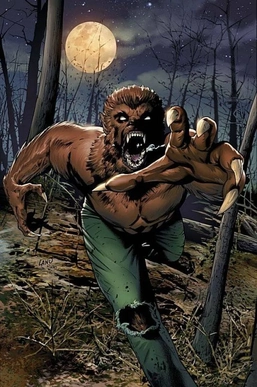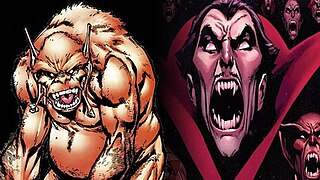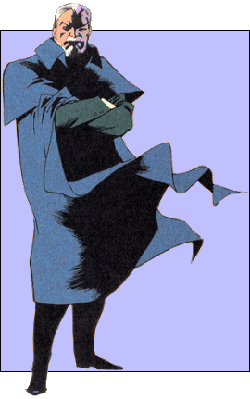
Blade is a fictional character and antihero appearing in American comic books published by Marvel Comics. Created by writer Marv Wolfman and penciller Gene Colan, his first appearance was in the comic book The Tomb of Dracula #10 as a supporting character, but he later went on to star in his own storylines. Devoting his life to ridding the world of all vampires, Blade utilizes his unique physiology to become the perfect vampire hunter. In Marvel comics, he is proficient in weaponry ranging from firearms to swords, and a master of martial arts. While originally depicted as a human immune to vampire bites, Blade was retroactively established to be a dhampir following his adaptation as such in Spider-Man: The Animated Series and the Blade film series. He is the father of Brielle "Bri" Brooks (Bloodline).

The Tomb of Dracula is an American horror comic book series published by Marvel Comics from April 1972 to August 1979. The 70-issue series featured a group of vampire hunters who fought Count Dracula and other supernatural menaces. On rare occasions, Dracula would work with these vampire hunters against a common threat or battle other supernatural threats on his own, but more often than not, he was the antagonist rather than protagonist. In addition to his supernatural battles in this series, Marvel's Dracula often served as a supervillain to other characters in the Marvel Universe, battling the likes of Blade the Vampire Slayer, Spider-Man, the Werewolf, the X-Men, Howard the Duck, and the licensed Robert E. Howard character Solomon Kane.

Hannibal King is a character appearing in American comic books published by Marvel Comics. He first appeared as a supporting character in the title The Tomb of Dracula, issue #25.

Professor Abraham Van Helsing is a fictional character from the 1897 gothic horror novel Dracula written by Bram Stoker. Van Helsing is a Dutch polymath doctor with a wide range of interests and accomplishments, partly attested by the string of letters that follows his name: "MD, D.Ph., D.Litt., etc.", indicating a wealth of experience, education and expertise. He is a doctor, professor, lawyer, philosopher, scientist, and metaphysician. The character is best known through many adaptations of the story as a vampire slayer, monster hunter and the arch-nemesis of Count Dracula, and the prototypical and the archetypal parapsychologist in subsequent works of paranormal fiction. Some later works tell new stories about Van Helsing, while others, such as Dracula (2020) and I Woke Up a Vampire (2023) have characters that are his descendants.

The Werewolf by Night is the name of two werewolves appearing in American comic books published by Marvel Comics. The first incarnation of Werewolf by Night, Jack Russell, first appeared in Marvel Spotlight #2. The second incarnation, Jake Gomez, first appeared in Werewolf by Night #1.

Varnae is a fictional character appearing in American comic books published by Marvel Comics. Created by Steve Perry and Steve Bissette, the character first appeared in Bizarre Adventures #33. Varnae is a villainous vampire who has been an adversary of several of Marvel's supernatural and fantasy-related heroes, and is a major character in Marvel's Dracula mythos. He is named after Dracula's literary predecessor, Varney the Vampire.

Spitfire is a fictional superheroine appearing in American comic books published by Marvel Comics. Created by Roy Thomas and Frank Robbins, the character first appeared in The Invaders comic book series as an intended replacement for the Union Jack character, but the costume design did not fit the female torso. Instead, the character of Spitfire, named after the Supermarine Spitfire fighter plane, was created.

Deacon Frost is a fictional character appearing in American comic books published by Marvel Comics. He appears in The Tomb of Dracula, and is an enemy of Blade. In the comics, Deacon Frost was depicted as a tall, white-haired, late middle-aged gentleman with red eyes, and wearing 1860s Germany period clothing. His doppelgänger sported an accent and attire that suggested a Southern preacher.

The Brides of Dracula are fictional characters in Bram Stoker's 1897 novel Dracula. They are three seductive vampire "sisters" who reside with Count Dracula in his castle in Transylvania, where they entice men with their beauty and charm, and then proceed to feed upon them. Dracula provides them with victims to devour, mainly implied to be infants.

The Midnight Sons are a team of supernatural superheroes appearing in American comic books published by Marvel Comics. Including Ghost Riders Danny Ketch and Johnny Blaze, Blade, and Morbius, the original team first formed as part of the Rise of the Midnight Sons story arc, culminating in the first full team appearance in Ghost Rider #31. Following the success of the crossovers, Marvel branded all stories involving the group with a distinct family imprint and cover treatment, which lasted from December 1993 to August 1994. The team has been revived several times with different characters, but the most frequent members include Morbius, Blade, and at least one Spirit of Vengeance.
Lilith is the name of two fictional characters appearing in American comic books published by Marvel Comics. The first version is the daughter of Dracula. The second version is a demon.

Nightstalkers is an American comic book series published by Marvel Comics from 1992 to 1994, featuring a trio of occult experts reluctantly banded together to fight supernatural threats. Operating under the business name Borderline Investigations, the team was composed of vampire hunters Blade and Frank Drake and private detective Hannibal King, all of whom had fought Count Dracula in the 1970s series The Tomb of Dracula. They are gathered by Doctor Strange in Nightstalkers #1 to battle an immediate threat, but under Strange's larger, hidden agenda.
Lucy Westenra is a fictional character in the 1897 novel Dracula by Bram Stoker. She is the 19-year-old daughter of a wealthy family and is Mina Murray's best friend. Early in the story, Lucy gets proposed to by three suitors, Arthur Holmwood, John Seward, and Quincey Morris, on the same day. Turning the latter two down due to already being in love with Arthur, she accepts his proposal. Before getting the chance to marry, Lucy becomes Count Dracula's first English victim, and despite Seward contacting Abraham Van Helsing for help, she transforms into a vampire. Following her return as a vampire and attacks on children—dubbed the "Bloofer Lady" by them—she is eventually cornered into her crypt by Van Helsing and her suitors who destroy her, putting her soul to rest.

Abraham Whistler is a fictional character appearing in the Blade film and television series. Developing the 1998 film Blade, screenwriter David S. Goyer created the character, and named him after Abraham van Helsing, the nemesis of Count Dracula from Bram Stoker's Dracula (1897). Whistler is a vampire hunter and Blade's mentor. Whistler is an original character created by Goyer, although some comparisons have been made to Jamal Afari who appeared in the comics as Blade's mentor. Kris Kristofferson was cast in the role and later reprised his role in Blade II (2002) and Blade: Trinity (2004). Ahead of Kristofferson's casting and the film's release, Whistler first appeared onscreen in Spider-Man: The Animated Series in 1995, adapted from Goyer's then-unfilmed screenplay, where he was originally voiced by Malcolm McDowell and later by Oliver Muirhead. In Blade: The Series (2006) a young Whistler was played by Adrian Glynn McMorran.

Dracula is a fictional character appearing in American comic books published by Marvel Comics. He is based on the vampire Count Dracula from the novel of the same name by author Bram Stoker. After the initial run of the series The Tomb of Dracula, the character has been depicted primarily as an antagonist to superheroes in the Marvel Universe.

Baron Blood is the name of several supervillains appearing in American comic books published by Marvel Comics. The first incarnation of Baron Blood, John Falsworth, first appeared in The Invaders #7, who has been part of the superhero Captain America's rogues gallery since World War II. The second incarnation, Victor Strange, debuted in Doctor Strange, Sorcerer Supreme vol. 3 #10. The third incarnation, Kenneth Crichton, made his first appearance in Captain America #253.
Janus is a fictional character appearing in American comic books published by Marvel Comics.
Noah van Helsing is a fictional character appearing in American comic books published by Marvel Comics. He is a supporting character of Blade.

Eric Cross Brooks is a superhero primarily portrayed by Wesley Snipes in the New Line Cinema Blade franchise—based on the Marvel Comics character of the same name—commonly known by his alias, Blade. Brooks is depicted as a dhampir with superhuman abilities after his mother was bitten by a vampire while giving birth to him. Brooks is trained as a vampire hunter by Abraham Whistler and dedicates himself to protecting humanity. A variation of the film's storyline was integrated into Spider-Man: The Animated Series by John Semper in 1995 ahead of the first Blade (1998) film, and Blade's redesigned costume and powers were integrated into comics in 1999. Snipes reprised his role in two further sequel films, Blade II (2002) and Blade: Trinity (2004), as well as in Deadpool & Wolverine (2024), which incorporated his iteration of the character into the Marvel Cinematic Universe (MCU) franchise through the multiverse. The character also appeared in Blade: The Series (2006), portrayed by Sticky Fingaz.
"Blood Hunt" is an American comic book crossover event, written by Jed MacKay with art by Pepe Larraz and Marte Gracia, published in 2024 by Marvel Comics. The event involves the rise of the Vampire Nation, which is united by a single vision for the first time in millennia.













